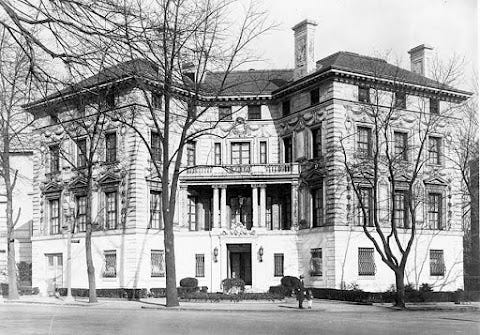Architect Stanford White in Washington, DC
Stanford White (1853-1906) was a name partner in the architectural firm of McKim, Mead & White, a preeminent firm of the Beaux-Arts architectural style. White specialized in designing private homes for the rich, and various public, institutional, and religious buildings.
White designed and decorated Fifth Avenue mansions for the Astors, the Vanderbilts, and other high society families. His Washington Square Arch still stands in Washington Square Park. He also designed club houses, which were focal points of New York society: the Century, Metropolitan, Players, Lambs, Colony and Harmonie clubs. In Washington, DC White designed homes for Thomas Nelson Page (1896) and Nellie Patterson (1903).

In Washington, DC, in addition to the homes of Nellie Patterson and Thomas Nelson Page, White is also known for the Adams Memorial in Rock Creek Cemetery, Washington, D.C. that serves as a grave marker for Marian Hooper Adams and Henry Adams. It features a cast bronze allegorical sculpture by Augustus Saint-Gaudens. Saint-Gaudens's sculpture is seated against a granite block which forms one side of a hexagonal plaza designed by White.
White was not only known as an architect, he was a decorator and designer of art objects, an art entrepreneur, and private collector. While on buying trips, he was known to ship vast loads of architectural and decorative treasures back to the United States in anticipation of new clients, filling his Gramercy Park, New York estate as well his Long Island country estate, Box Hill.
By the 1890s, Stanford White had become a very prominent and notorious personality in New York social circles, much to the dismay of his more staid architectural firm partners, ultimately meeting an untimely and public death in 1906. Only three years after completing the Patterson house, White was shot dead at Madison Square Garden in New York by Harry Kendall Thaw, the husband of Evelyn Nesbit, a popular American chorus girl with whom White had earlier had an affair.
William Randolph Hearst played up the murder in his newspapers, with it becoming known as the "Trial of the Century." The story became the basis of the 1955 movie The Girl in the Red Velvet Swing, starring Ray Milland as Stanford White and Joan Collins as Evelyn Nesbit Thaw.

After his murder, White's extensive collections were auctioned off. Architect Howard Greenley (1874–1963) purchased a large-scale antique Italian painted ceiling that White had bought from the Italian dealer Stefano Bardini, which he had installed in the entrance hall of the Dupont Circle home of whiskey distiller Edson Bradley. That ceiling, along with the other interior contents of the Dupont Circle house, was moved to the Bradley's new home Seaview Terrace in Newport, Rhode Island.







